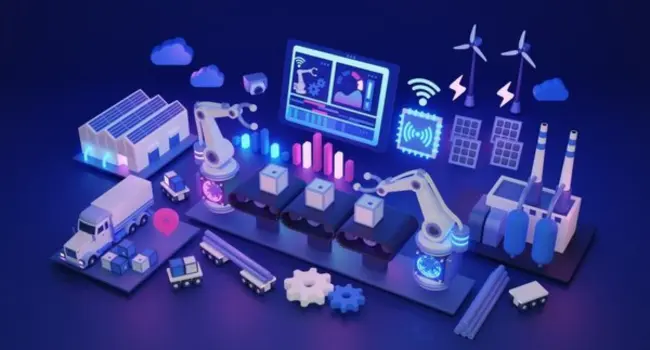Smarter Manufacturing with IoT: A Guide to Smart Factories
The Internet of Things (IoT) is transforming the manufacturing world. In today’s smart factories, machines, sensors, and systems work together and share data in real time. This approach—part of the broader Industry 4.0 movement—helps businesses become more efficient, agile, and future-ready.
By connecting tools and equipment, factories can speed up production, improve product quality, reduce downtime, and boost worker safety. Welcome to the age of smart manufacturing.
Why IoT Matters in Manufacturing
Smart factories rely on Industrial IoT (IIoT) and cyber-physical systems (CPS). These technologies make it possible for machines and computers to work as a team—leading to automation, business agility, and faster innovation. They help businesses test ideas quickly, adapt to change, and prepare for future challenges.
Getting Started: Building Your Smart Factory
1. Understand Your Needs
Before jumping in, assess what you want to improve. Is it better visibility in your supply chain? Less waste? Faster production? Measure your digital maturity and prepare a strategy with clear goals and team roles.
2. Choose the Right Tools
Start small with IoT sensors, RFID trackers, and smart devices like Digi XBee modules or Digi Connect Sensor+. These tools collect data, track items, and provide visibility at every stage. Pair them with strong gateways and routers to keep your system connected and secure.
3. Begin with a Pilot Project
You don’t need to upgrade everything at once. Try automating a simple task—like turning off idle machines. Use tools like over-the-air updates (OTA) and digital work instructions to test and learn. Small wins build confidence and guide broader changes.
4. Train and Upskill Your Workforce
Technology means nothing without people. Offer hands-on training using augmented reality to make complex tasks easier. Teach your team how to use new systems safely and effectively. A skilled team is key to long-term success.
5. Scale Smartly
Use agile operations to scale gradually. Incorporate smart warehousing and demand-driven manufacturing to avoid overproduction. Each step should build on the last, helping your factory become stronger and smarter over time.
Benefits of IoT in Manufacturing
1. Real-Time Monitoring
IoT devices track machine performance 24/7. If something goes wrong, alerts are sent immediately, preventing major issues. Dashboards and analytics tools help managers make quick decisions.
2. Better Product Quality
Smart sensors can detect tiny flaws early—something the human eye might miss. This helps improve defect detection and ensures consistent product quality, reducing waste and keeping customers satisfied.
3. Less Downtime
Predictive maintenance lets you fix machines before they fail. IoT tools detect faults and alert teams, reducing repair costs and production stops.
4. Improved Worker Safety
IoT tools monitor heat, air, and noise levels, warning workers before danger arises. Dangerous tasks can be automated, keeping workers out of harm’s way.
5. Lower Operating Costs
Smarter machines and better energy use mean cost savings. Factories can increase ROI (return on investment) by producing more with fewer mistakes and less waste.
6. Energy Efficiency
IoT tools help manage energy use, turning equipment on or off as needed. This reduces your carbon footprint and supports sustainable production.
7. More Flexibility
Factories can quickly shift to meet changing customer demands. With just-in-time production, you make what’s needed, when it’s needed—minimizing waste and storage issues.
8. Smarter Decisions with Data
IoT systems generate real-time data, offering insights into performance and problems. Managers can act faster and with greater confidence using visualized data and trends.
9. Scalable Growth
With IoT, your factory can expand without major disruptions. Smart tools support gradual growth, tracking key metrics like Overall Equipment Effectiveness (OEE) to ensure you’re on track.
How IoT Works in Smart Factories
Connected Machines and Smart Sensors
Machines talk to each other through machine-to-machine communication, using embedded sensors to collect and share data instantly—even from hard-to-reach areas.
Data and Automation
IoT gathers real-time data and analyzes it with AI and big data tools. This helps factories understand what’s working and what’s not. Automation tools—even remote controls—allow managers to operate machinery from anywhere.
Cloud + Edge Computing
Data is stored and processed via cloud platforms, while edge computing handles fast decisions closer to the machine. This combo ensures factories are fast, reliable, and responsive.
Key Supporting Technologies
- High-Performance Routers: Keep everything connected and secure.
- Embedded Systems: Mini computers inside machines for smarter tasks.
- 5G Networks: Enable high-speed, real-time data sharing.
- Cloud Platforms: Manage devices, store data, and organize workflows.
- Cybersecurity Tools: Protect devices and data from hackers.
- Blockchain: Secure and verify data logs and product history.
- AI & Machine Learning: Help machines learn, optimize, and improve performance over time.
Challenges to Watch For
- Security Risks: IoT increases the attack surface. Invest in strong identity authentication and data encryption.
- High Costs: Initial setup can be expensive, especially for small businesses.
- Legacy Machines: Older systems may need integration tools or upgrades.
- Skill Gaps: Train your workforce to handle smart tools.
- Data Management: Handle large volumes of data efficiently.
- Network Reliability: Stable internet is essential for smooth operation.
The Future of IoT in Manufacturing
Looking ahead, smart factories will:
- Rely more on robotics and AI for autonomous decision-making.
- Embrace green manufacturing with energy monitoring and waste reduction.
- Use AR and VR for training and guided work.
- Offer servitization—providing services like maintenance and upgrades alongside products.
With real-time insights, flexible systems, and connected machines, the future of manufacturing is smarter, cleaner, and more efficient.
Final Thoughts
IoT is not just a tech trend—it’s the foundation of the modern manufacturing revolution. Whether you’re starting small or scaling up, investing in IoT today means building a more agile, sustainable, and competitive factory for tomorrow.If you want to Learn more visit our website tech data tree.
